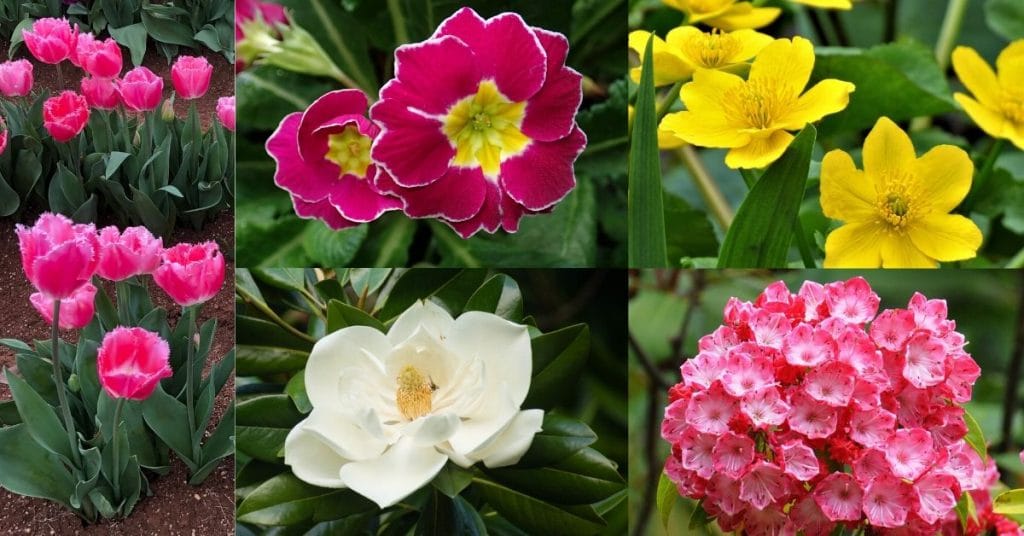After the harsh cold winter chill comes the spring season, a period when days become longer and the temperature gradually rises. Animals wake up from hibernation and start being active in the wild again and of course, the bland white snow is replaced with the welcome green leaves of plants.
What better way to celebrate the arrival of early spring than to plant some gorgeous spring flowers? In this post, we’ll tell you everything you need to know about how to grow spring bloomers. We’ll also break down the best early spring flowers and late spring flowers to grow in your garden!
Whether you’re dealing with partial shade or full sun, there are spring flowers out there just waiting for you.
- Why Choose Early Spring Flowers?
- Mid and Early Spring Flowers
- Late Spring Flowers
- Anemone
- Allium
- Azalea
- Barbados cherry
- Bleeding heart
- Common Bluet
- Blue star
- Candytuft
- Eastern redbud
- Freesia
- Halesia tetraptera
- Helianthemum apenninum
- Iris
- Kalmia latifolia
- Jasmine
- Abelia
- Lasthenia conjugens
- Lesser celandine
- Lilac
- Jacob’s Ladder
- Geranium
- Malus coronaria
- Magnolia grandiflora
- Myrtle
- Chestnut oak
- Peonies
- Primrose
- Prunus glandulosa
- Pulsatilla vulgaris
- Siberian bugloss
- Spring Snowflake
- Tulips
- Yellow trillium
Why Choose Early Spring Flowers?
One of the best reasons to plant early spring flowers is for the true joy that an early spring garden brings to anyone who beholds it.
Many plants that have gone bare start to produce new leaves and flowers and this is when spring truly spreads a feeling of warmth. Several cultures around the world celebrate the start of spring because this is the time when crops are sown and flower buds bloom.
The more favourable environment allows the early springflowers to open up and spread their beauty and color across the fading white of winter. These spring flowers provide comfort and cheerfulness that somehow signals rebirth and inspire an active lifestyle once again.
However, not all plants bloom at the start of spring. Some spring flowers open up as soon as the snow starts melting and some prefer warmer days as summer approaches. There are also long-lasting and repeat bloomers that display their flowers from spring throughout the rest of the year.
It is nice to be familiar with the spring flower blooms that make spring a wonderful season, may it be just as a handy fact or for gardening purposes. There are many flowering plants that emphasize the rejuvenating vibe of spring so if you want to learn about them, check out this list of the best refreshing flowers that bloom in early, mid, and late spring.
Mid and Early Spring Flowers
If you’re looking for early spring flowers that thrive in full sun to part shade and will appear first thing in the spring – in some cases, as early as late winter – these are the flowers you’ll want to choose for an early spring garden.
Bloodroot
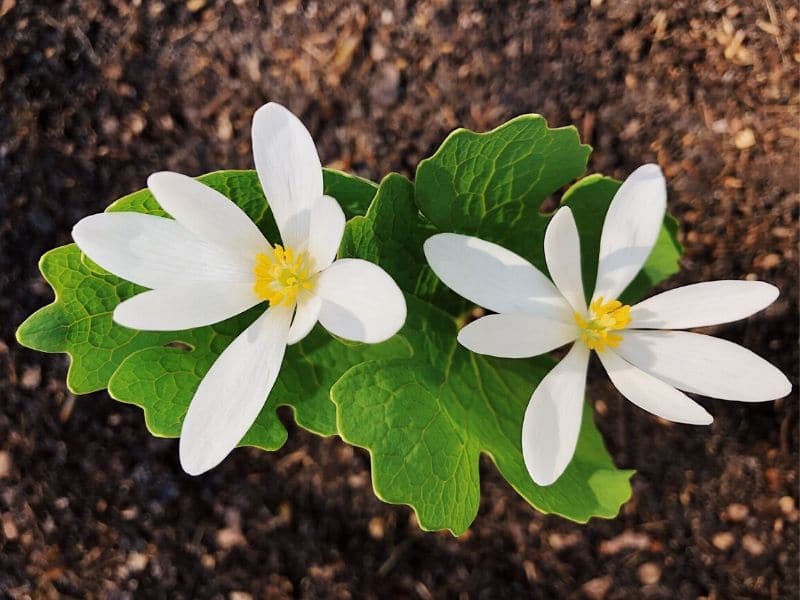
Bloodroot is among the few wildflowers that bloom in early spring. The scientific name is Sanguinaria canadensis in reference to the red-colored sap from the plant’s roots and to Canada where the plant originated (1).
It is known for its 8 to 11-petalled star-like flower that is perfectly white with a yellow stamen. At the onset of spring, it blooms from a bud that is initially wrapped in a deeply lobed single foliage that lasts throughout summer (2).
The Native Americans used the rhizome of these spring flowers as an ingredient in toothpaste. It is also a main constituent in agricultural feed supplements and treatment for osteoarthritis (1).
Common Bluebell

The bluebell is a type of lily called Hyacinthoides that signals the onset of spring as it grows and forms a thicket of blue-violet spring flower blooms in woodlands and gardens. The delicate flowers quickly emerge from the bulbs and produce a sweet fragrance that has become a signature of springtime in Western Europe.
These spring flowers have elongated basal leaves and twice as long stalks bearing 4 to 16 blue bell-shaped flowers. Bluebells normally provide a brief spring bloom as landscape borders or groundcovers as well as tree under-plantings. In ancient times, bluebells are used as glue in book-binding but they are also known as poisonous when ingested in large quantities (2).
Camellia
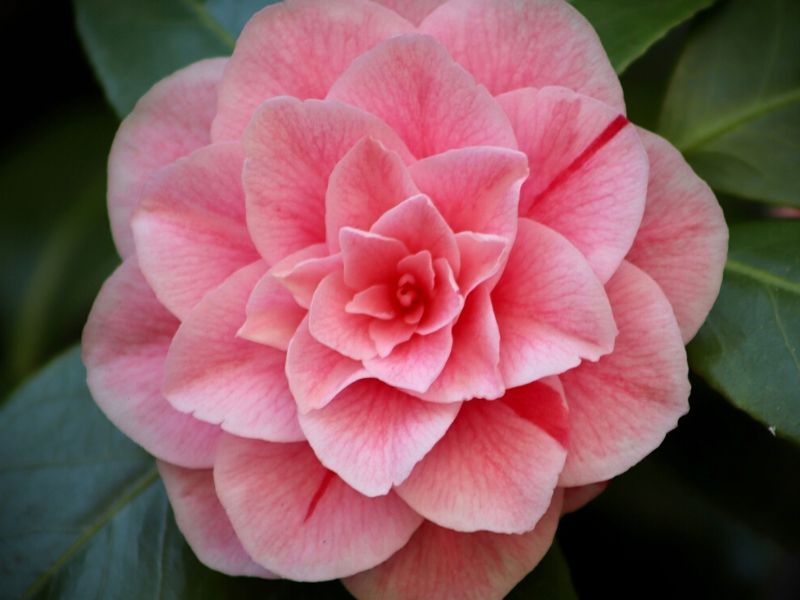
Originating from Eastern Asia, camellia plants were initially grown for their medicinal properties but the gorgeous flowers they produce every spring caught the eyes of cultivators making them widely known as ornamental plants instead. The colors ranging from buttery yellow to pink to red add to the delicate nature of early spring.
These spring flowers grow best in slightly acidic soil and in areas where there is enough sunlight. Pruning is also a common practice to keep the plant’s height as recommended and to make room for more spring flower blooms (3).
Claytonia
These early spring bloomers appear grass-like emerging from an underground corm and as spring approaches, it starts producing delightful pink or white 5-petalled, lined flowers with pink pollens too!
These short-lived spring flowers, commonly known as Virginia spring beauty, last for only 3 days but the spring flowers continuously bloom for over a month. The early spring flowers bloom in the morning and close at night or when the weather is cloudy.
They form a dense floral carpet in forests and open woods which is truly a magnificent view, justifying the plant’s common name, ‘Spring beauty’! One favorite variety is C. caroliniana with the same floral feature but with unique elliptical leaves (2).
Chionodoxa

Chionodoxa is derived from the Greek words ‘chion’, meaning snow, and ‘doxa’, meaning glory, hence the common name, Glory-of-the-snow. This may be attributed to the plant’s ability to bloom in late winter and early spring.
Native to Europe, glory-of-the-snow thrives in well-drained soil under full sunlight. It takes advantage of the bare deciduous trees in late winter and produces racemes of starry flowers with purple-blue petals and white center. The green leaves are long and slender, emerging from bulbs (4).
With the right conditions, they grow and bloom fast making them perfect as border or edging plants, near houses where they can be well-appreciated.
Coltsfoot
Coltsfoot is a perennial plant that resembles a dandelion with its bright yellow flowers. The plant got its name from the smooth, waxy leaves that look like hooves. It belongs to the Aster family, blooms in early spring and withers before any of its leaves emerge. Because of this, the plant is also called ‘son before the father’.
Often found in riverbanks, ditches, and roadsides, coltsfoot is considered a bad weed in Europe. They can be difficult to weed out because of the extensive root system but it also keeps the soil intact, avoiding erosion, especially on sloped areas (5).
Daffodil

These droopy daffodil flowers are the go-to of gardeners and florists seeking the iconic yellow of early spring. Also known as Narcissus, these spring flowers are associated with a Greek folklore about beauty, youthfulness, and self-love and this rich cultural background only adds to the subtle charm of the flower (6).
Some of the popular varieties are the orange-centered ‘Berlin’ and the white petalled ‘Replete.’ They grow best in slightly acidic soil under the full sun to part shade. They are often planted together with hyacinths for a variation in color.
Dutch crocus
Dutch crocuses provide the bright colors of early spring. The colors range from ivory white to yellow-chrome to royal purple making the six-petalled funnel-shaped flowers even more fascinating and make them instantly pop against the long grass-like foliage. Because of its early blooming nature, this early spring flower is found scattered in gardens, along pathways, and under tree canopies.
Dutch crocuses belong to the Iris family and grow from corms. Planting them in clayey soil must be avoided since this will hinder the emergence of new shoots from the underground stem. Well-drained soil and full sun are best for these spring flowers (2).
Early Star of Bethlehem
The Early Star of Bethlehem is a lily plant also called Gagea bohemica. One of the many flowering plants that bloom in the spring, this early spring flower showcases short-lived, star-like flowers that have 6 bright yellow petals with a slight green underside.
These spring flowers only bloom when the sun is up, usually during the first 3 weeks of spring. It is also known for its thin, thread-like twisting basal leaves (7).
These early spring flowers are abundant in bushy forests and river banks. The starchy bulb of the plant is edible but the early star of Bethlehem plant is more popular as a groundcover for gardens and parks.
Forsythia

Forsythia is named after William Forsyth, one of the founding fathers of the Royal Horticultural Society. The funnel-shaped flowers bloom on the stems as spring starts. The green leaf buds then start to grow as the spring flowers wilt and turn a slight shade of purple towards the end of the season.
Forsythias originated in Eastern Asia. They prefer full sun and a well-drained location and most growers apply mulch around the base of the plant to keep the moisture in the soil. ‘Fiesta’ is a popular variety grown in novelty gardens for the plant foliage that come in two shades of color (8).
Ghost Plant

Unlike most spring flowers with slender leaves, ghost flower or Graptopetalum paraguayense is a succulent with thick, juicy leaves that grow in a rosette form. In full sun, the fleshy leaves of the ghost flower are yellow-pink but turn bluish-grey in shade. The white star-shaped flowers appear in mid-spring.
They are small plants usually about 10 cm tall that can be grown as a houseplant. The plant has a trailing growth habit so they can be hung or in some unique instances, they are grown as a ground cover. An excellent drought-tolerant plant, this species requires less water and minimal maintenance (9).
Harbinger of Spring
This early spring flower is also called Erigenia bulbosa and produces one of the daintiest flowers of spring. The month-long blooming of the tiny wildflowers are usually seen covering the grounds of humus-rich forests, rocky canyons, and wooded slopes along rivers. The plant also produces green leaflets on long and stout light green to reddish-brown stems.
Another name for the harbinger of spring is ‘pepper and salt’ plant because of the bright white petals and black anthers of the spring flowers. These spring flowers produce sweet nectar that attracts bees and miscellaneous flies (10).
Hellebore
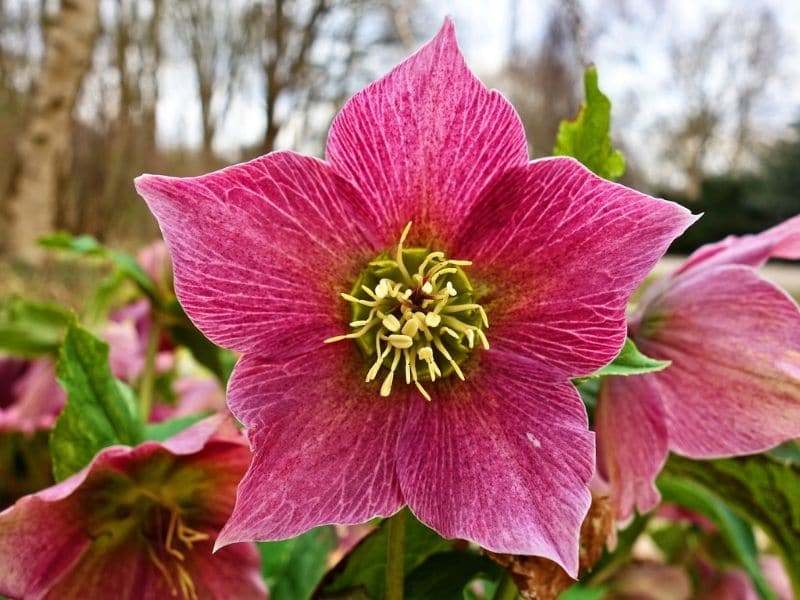
Hellebores are perennial buttercup plants that produce 5 rose-like flowers in shades of red, purple, yellow, green, and blue. They even have unique spotting and veining details on the droopy flowers which make them attractive borders or mass plantings.
The plant originated from Europe and Asia and has been popularly cultivated because of the evergreen foliage and decorative characteristics. H. orientalis also known as Lenten rose blooms in early spring and has become symbolic of the Lenten season (11). If you’re considering enhancing your garden, explore the world of Hellebore companion plants to complement these stunning blooms.
Hyacinth
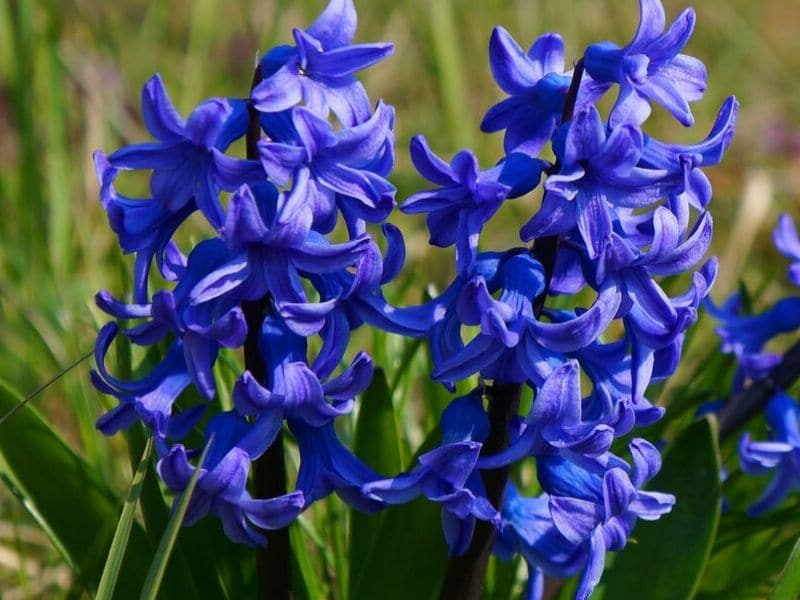
Hyacinths have become a figure of spring because of the one of a kind bloom and the lovely fragrance of the early spring flowers. The clusters of spring flowers that come in white, pink, apricot, lavender, and yellow provide a pop of color that reminds of playfulness and youth.
Rows of this early spring flower in different colors are a popular way of planting them in gardens. Gardeners plant them under full sun and once the blossoms have dried in the summer, the floral stalks are cut back to allow the plant bulbs to store food for the next spring bloom although these bulbs only last for three to four years (4).
Field Wood Rush
Also known as luzula campestris, this perennial grass-like plant is considered as a weed in most residential lawns but it is native to grasslands of temperate Europe. They are oftentimes cultivated in golf-course fields.
It can be identified by its rhizomatous growth and broad, slender dark green leaves. The light-green flowers are clustered atop a floral stalk (12).
Because of the early-flowering habit, these early spring flowers are also known as ‘Good Friday grass’. The plant requires moderately acidic soil and partial sun to thrive. It also produces tiny light seeds that are easily dispersed making them notorious weeds in ornamental turf.
Marsh marigold
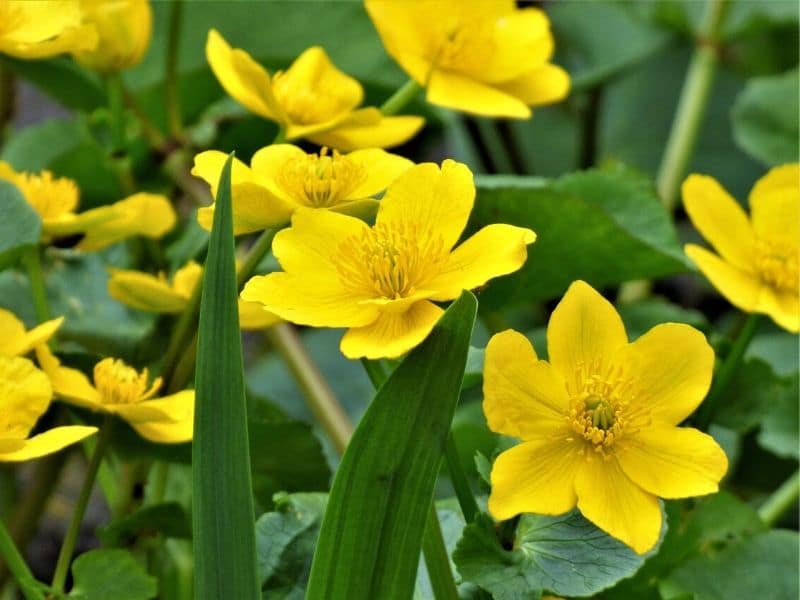
Marsh marigold or Caltha palustris is actually not a marigold but a buttercup plant. It is called such because of the familiar bright golden flowers.
Another common name is ‘Cowslip’ referring to how cows would slip on these early spring flowers when they try to drink from the river streams.
The wildflowers bloom from April to May creating a yellow carpet in marshes and woodlands which has become iconic of spring season in Europe and Asia. The broad glossy kidney-shaped leaves of these early spring flowers provide a dark green contrast and can be eaten as well (13).
Pansy
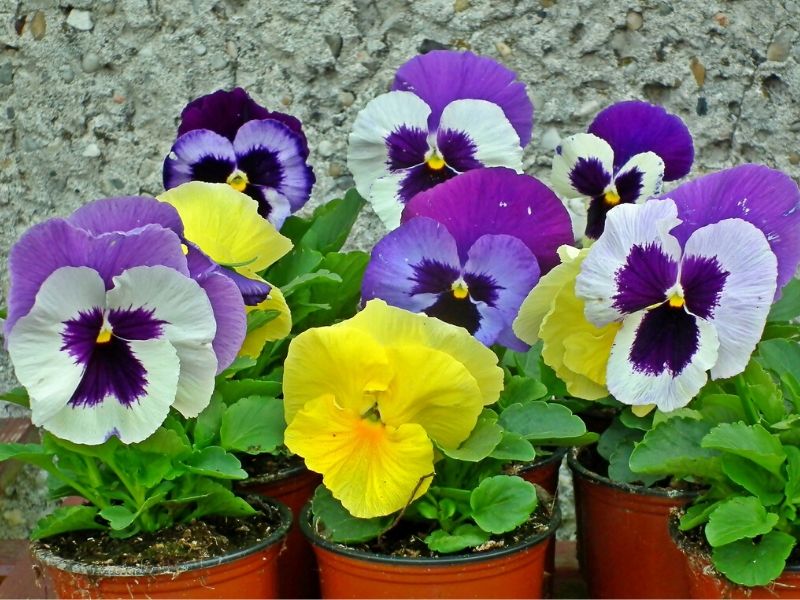
Pansies are cool weather annual plants. They are preferably planted in the winter, in time to bloom for spring and even through fall. A member of the Violet Family, they are large brightly colored early spring flowers that are known for their overlapping petals and are grown as bedding (14).
The name pansy is derived from the French word, ‘pensee’ or thought since the flower is considered a symbol of remembrance.
Pansies have been cultivated throughout history and varied floral colors, as well as varieties with extended blooming periods, exist today. Among the favorites is the award-winning Joker Series because of the colorful “face markings” on the early spring flowers.
Phlox
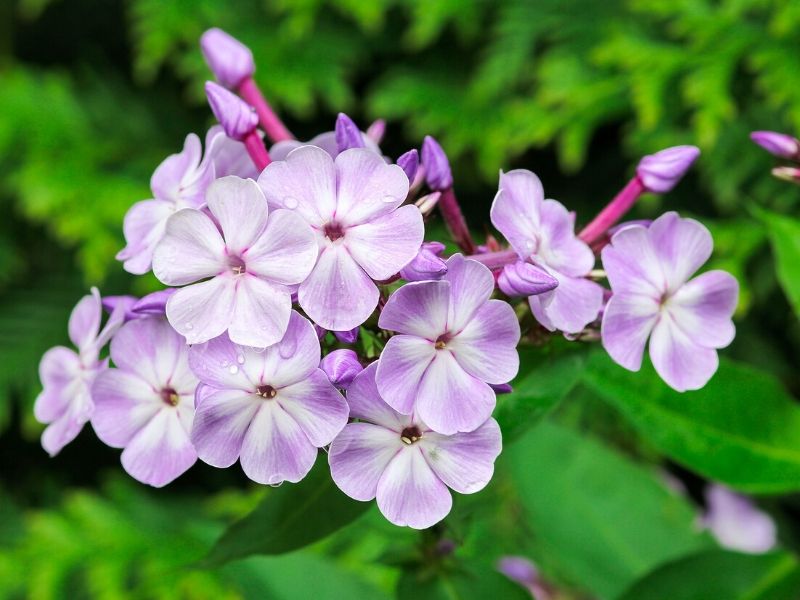
Phlox is a prolific flowering plant that covers rock gardens and mountain grounds in dense masses. It is also called ‘moss pink’ because of the plant’s creeping growth habit and the common pink or lavender early spring flowers. The small soft pointed leaves are rarely noticeable because profusely packed blossoms.
Phlox is preferably planted on slope areas where their spring blooms are better appreciated but it can be grown as groundcover and borders that define lawns and pathways. The plants like full sun and require frequent watering especially during summer (14).
Puschkinia
Named after the Russian botanist, Apollo Mussin-Pushkin, this early spring flower provides a white to blue ground cover in spring. It is a bulbous plant from the Asparagus family that is native to the Middle East.
The floral cluster called raceme bears fine silvery blue bell flowers that bloom from March to April. After the flowering period, what remains are the pairs of green grass-like foliage (4).
Puschkinias are fairly resistant to pests and easily adapt to different environments but they grow best in well-lit areas and moderately moist soil. They take time to mature but if they are left undisturbed in this preferable environment, they will produce the best masses of flowers every spring.
Ranunculus
Ranunculus is one of the spring flowers beautiful and hardy enough to be used as a cut flower. The rose-like flowers in colors of cream, yellow, orange, red and purple are so enchanting.
Because of their superior qualities like citrusy fragrance, long stems, flawless blooms, and high yield, they are considered as one of the high-end flowers used in special bouquets.
Although they are commercially grown in greenhouses which provide spring-like conditions all year-round, ranunculus plants can be grown outdoors as landscape borders as well and they are usually paired with primroses and larkspur for a variety of texture and color in a spring garden (13).
Rock cress
Rock cress or Arabis is an herbaceous perennial plant that forms a dense, fine-textured growth on rocky areas. It produces small narrow leaves that stay green through the seasons and in spring, simple fragrant purple flowers with yellow anthers almost cover all the plant’s foliage and spills over the container when potted.
Rock cress is classified as a low maintenance plant, requiring a small amount of water during hot summer days and full sunlight conditions. The only practice it needs is pruning after the last flowers have wilted to ensure a denser growth which will showcase the fine-textured leaves for the coming seasons (15).
Scilla

The wave of colors the scilla plant provides has been a staple of the early spring season. The erect tufts topped with racemes of pastel flowers add a dimension to gardens and landscapes, under the trees or beside active streams and passive ponds. The bulbous plant also multiplies quickly so propagation during the dormant season is fairly easy (4).
Scilla campanulata or wood hyacinth provide the multi-colored blossoms while Scilla siberica or Siberian squill bears the striking cobalt blue flowers. Both these species multiply very quickly so planting in areas with less competition should be kept in mind.
Snowdrop

This milk-colored snowdrop flower retains the white of the winter throughout the spring season. The dainty bell-shaped flowers dangle in the air as the white snow thaws. They are a beautiful sight to see especially when mixed with the more brightly colored daffodils and buttercups. They are often planted along pathways and under tall shrubs or trees.
Snowdrops belong to a small group of plants under the Amaryllis family and some species are considered endangered (4).
Columbine

Columbines, also known as Aquilegias are members of the buttercup family that produce lovely flowers in shades of red, pink, purple, and blue. The trumpet-like flowers are usually two-toned with the yellow anther protruding. They are further accentuated by the green, fern-like leaves (15).
Perfectly-growing under full sun and warm areas, the plant is drought-tolerant and is an easy option to plant in woodland themed landscapes.
Popular ornamental species are A. canadensis with red, downward-facing blossoms, A. caerulea, a blue variety, and A. fragrans with the sweet-scented yellow and white flowers.
Sterculia colorata
The unique beauty of this otherwise known ‘Bonfire Tree’ sets it apart from the rest of the world’s flora. The early spring flowers of this tree start out as buds on branches that go bare before the onset of spring. They bloom into elongated bright scarlet florets forming a dense panicle hanging at the ends of the branches.
The inflorescence is truly stunning although the same cannot be said of the odor these spring flowers and the leaves release. This is actually the reason behind the name of the tree which was derived from the Latin word for dung (16).
Winter Aconite
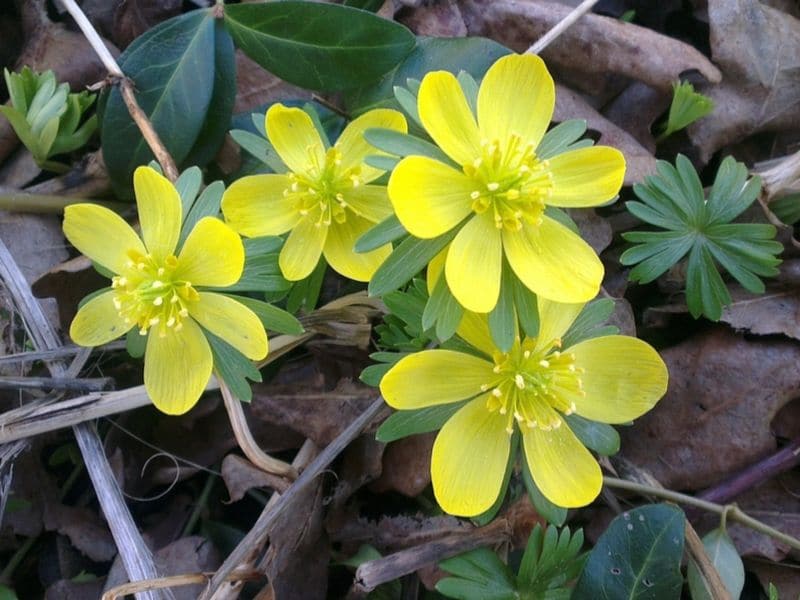
Winter aconite is one of the toughest, early blooming spring flowers. It is also called Eranthis which means spring flower but the common name refers to the plant’s ability to bloom as winter concludes when the snow is already thawing (17).
In late winter, the bright yellow, cup-shaped dainty flowers start to spread out. Following the emergence of these spring flowers are the green frilled leaves.
The plants can be divided so that the growing tubers can be used as planting materials. Because these tubers tend to dry out, it is advisable to soak them overnight before planting (18).
Witch hazel
Witch hazel or Hamamelis is a shrub that bursts into vibrant color as spring season starts. The plant has a beautiful gray bark and stunning shape but the majestic yellow to orange and fragrant clusters of spring flowers that grow abundantly on the plant’s bare stems are what makes this plant deeply appreciated (19).
Coupled with under planting of other vernal short plants, witch hazels become effective as hedges or screens. The upright growth and vertical branching of this plant are further defined by the blossoms but it is important to prune witch hazel to keep the height under control and also to promote more prolific flowering.
Late Spring Flowers
If an early spring garden isn’t for you, don’t worry. There are spring blooms that appear later in the season, too. Consider some of these late spring flowers – some of which bloom all the way until late fall!
Anemone
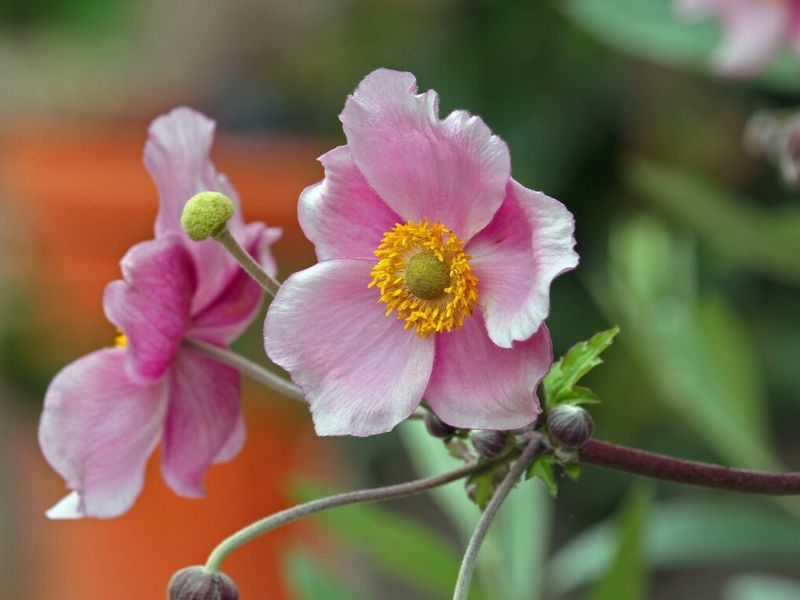
Anemones are the perfect plants to grow to keep the vibrant colors lasting throughout the spring season. They bear catchy daisy-like flowers with a dark-colored center that just start to bloom when the vernal snowdrops are beginning to wilt.
The plant has a compact growth which makes them perfect groundcovers and garden accents. The white, pink, or purple flowers may overpower the soft fern-like foliage but they are still bound to turn heads.
Aside from this garden use, anemones are also outstanding cut flowers that have 2 to 3 weeks of vase life. Perfect example varieties are ‘De Caen’ and ‘St. Brigid’ (19).
Allium
Some may think about onions when they hear alliums but these ornamental onions are among the amazing plants that showcase their whimsical flowers in late spring.
Alliums produce a globe-like flower head that consists of individual florets in white, purple, pink, yellow or blue (19). This head is held by a 5-in flower stalk making it look like protruding textured lollipops from the ground.
Alliums create an original playful twist to any garden design and they can definitely serve as a focal point to landscapes. Although they thrive best in fully lit conditions and well-drained soil where their bulbs can multiply.
Azalea

Azaleas are no-doubt show stoppers. A single shrub can produce an abundance of its brightly colored flowers enough to bring back life to any garden recovering from winter. The early spring flowers vary from pink to white to orange to red lasting up to 3 weeks (20).
Aside from this, the plant also produces lovely and healthy green foliage that takes care of the beauty of the plant even when the blossoms aren’t there. But it should be noted that in order for the plant to produce more flower buds, watering should be monitored especially during dry weather.
Barbados cherry
Also known as Malphigia or Acerola, the Barbados cherry is a native of the West Indies cultivated for its delicious fruit which is used in manufacturing vitamin C tablets!
But late in spring, it also starts to produce slightly fragrant lovely pink or white flowers with yellow centers which create a vertical variation and color in the landscape (21).
Several Barbados cherry plants when planted in groups, provide a great screen and garden accent even without the spring flowers since they bear long-lasting glossy green leaves. The plant is also drought-tolerant so coupled with good drainage and partial shade, the Barbados cherry will thrive well.
Bleeding heart

Also known as Lamprocapnos, this spectacular red, sometimes white, flower bears the silhouette of a heart that is bleeding, hence the name. Several heart-shaped flowers dangle on a long, arching stem forming a cluster called raceme. The striking blossoms stand out against the background of sea-green, soft fern-like leaves (18).
This perennial plant is traditionally grown as a border together with other shade-loving plants. It is ideal to have a combination of companion plants so that the garden will retain color once the bleeding heart goes dormant. When gardening, this plant should be handled with care since it can be poisonous and may also cause skin irritation (17).
Common Bluet
Also called Houstonia caerulea because of the baby blue color of the spring flowers, the common bluets provide gardens the blue they lack in late spring. They are tiny but captivating plants that are sometimes considered weeds with their abundance in moist, open spaces from late April to early July.
Common bluets are naturally found in meadows, open woods, and rocky streams where the soil is moist and slightly acidic and full sunlight is available. The small rosette of leaves form mounds where wiry tufts grow bearing the flower on their ends. The early spring flowers have four light blue petals with a bright yellow center (22).
Blue star

Amsonias are known for their star-shaped floral display in late spring. Otherwise known as ‘Blue Star’, the five-petalled powder blue flowers form a cluster atop a 2 to 3 feet-long stem filled with needle-like foliage. Although best known for their eye-catching golden leaves during fall, the starry flowers are still popular with bees and florists alike (23).
This plant is quite hardy and very adaptable to several conditions. It prefers well-drained soil and full sun for optimum growth. Blue stars are generally resistant to pests aside from a few occasions of rust. To propagate, established clumps can be divided and transplanted before they start blooming (17).
Candytuft
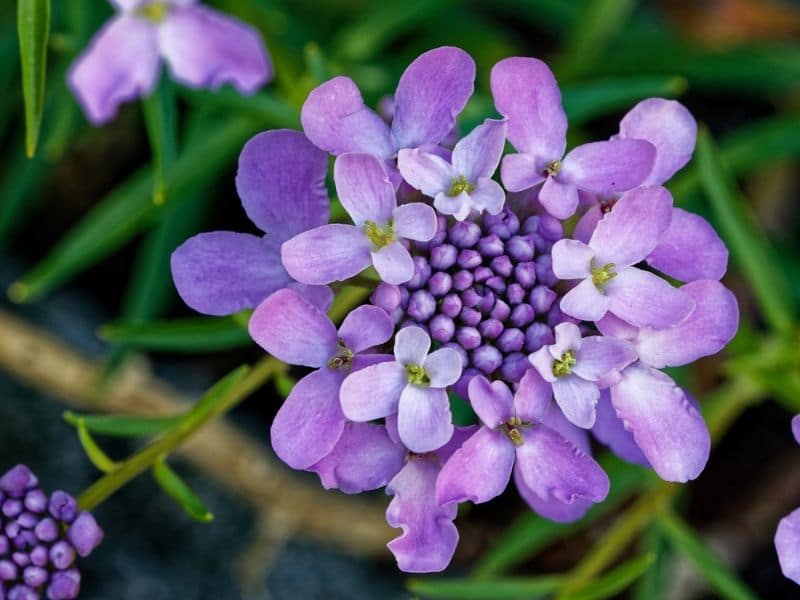
The name ‘Candytuft’ has a sweet ring to it, fitting for a flowering plant associated with spring. But the plant, also known as Iberis has nothing to do with sweets. The name was actually derived from the island of Crete, previously called Candia, where the plant originated. Tuft refers to the clustered formation of its early spring flowers (24).
This flowering plant begins blooming in late April until the end of June. The early spring flowers come in white, pink, and purple clustered into a floral structure called umbel. They can be used as cut flowers, container plant, annual bedding, and borders or as pathway edging.
Read more: Candytuft Companion Plants
Eastern redbud
One of the most attractive late-spring blooming plants, eastern redbud is a unique addition to any landscape. Like the Bonfire tree, this plant bears the spring flowers on the branches but the magenta blooms cluster together and can surprisingly cover up the entire length of the branches! Leaf buds only start to appear in summer (25).
Eastern redbud is scientifically called Cercis canadensis and apparently originated from Canada. It is susceptible to canker disease caused by a type of fungi which can lead to the death of the plant starting from the branches so, at the sight of dark wilting spots, fungicide must immediately be applied.
Freesia
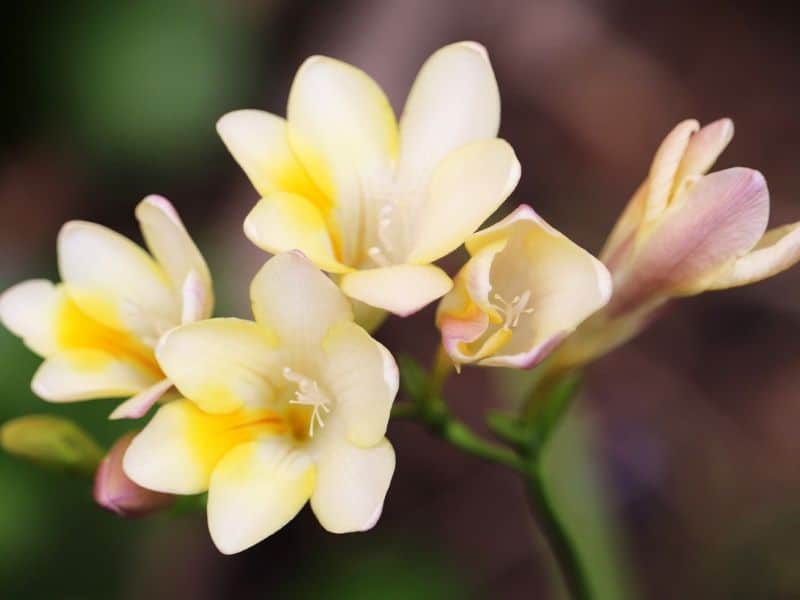
Freesias provide a floral display of colors during spring which makes them some of the widely planted flowering plants in many parts of the world. After the emergence of flat leaves from bulbs, a series of tubular blossoms in white, yellow, purple or red follow suit for the next six weeks.
Rocky areas fully lit by the sun is the favorite home of this flowering plant. It is fairly hardy, able to withstand dry conditions, although it still requires a fertile soil. To propagate, the corms must be 2 inches deep below the soil surface, watered weekly, and annually applied with slow-release fertilizer (26).
Halesia tetraptera
This plant is also called silverbell in reference to its white or pink bell-shaped flowers. They grow in clusters of 2-6 flowers on wiry stems of the shrub.
Originating from Eastern Asia, the flowering plants were introduced to Europe and America and has been grown in parks and residential gardens. The small shrubs usually line sidewalks or when grown as a tree, they make a good landscape specimen.
Silverbells prefer acidic, well-drained soil and can tolerate full sun or partial shade. Favorite species among gardeners are H. diptera with larger flowers and ‘Carolina’ variety for its pink-blushed blossoms (27).
Helianthemum apenninum
A member of broadleaf evergreen shrubs that originated from the Mediterranean, this is a sun-loving plant that blooms from late spring to midsummer.
It is otherwise called ‘rock rose’ for the spring flowers resemble species roses and are usually found growing in rocky woodlands where the soil is both sandy and clayey.
Most rock roses are white in color but there are pink, yellow, and orange ones as well. The plant has a sprawling growth habit so it can be ornamentally grown as a ground cover or border plant. Butterflies also fancy this plant so that makes for a lovely relaxing wildflower garden (27).
Iris

Named after the Greek goddess of the rainbow, irises are truly marvellous flowers of spring. The six-petalled flowers come in many shades of colors and the long thin leaves only add character to the plant. They grow in marshes as they prefer moist soil and sunny areas but they can adapt well in residential gardens and parks (14).
The iris flower is symbolic of faith, valor, and wisdom and is said to be the inspiration for the French insignia, the Fleur-de-Lys. A bouquet of this flower means congratulations and in Japan, the spring flowers are hanged by the doors to ward off evil spirits.
Kalmia latifolia
Kalmia or mountain laurel is an evergreen shrub originally found in meadows and woodlands of North America. It is known for its dense bush made of glossy dark green broad leaves.
In late spring, the plant produces a spectacular bloom of pink and red or blush and white. The delicate fused petals come in cluster with sensitive anthers that release pollen when touched (27).
This plant is excellent for shaded gardens where it will provide the showy flowers shadowy areas lack. Although it is important to note that every part of the mountain laurel is poisonous when ingested.
Jasmine

The jasmine is truly a gift from God when its flowers start blooming in spring. The white cluster of flowers open into star-shaped blossoms and release a lovely sweet scent. They definitely stand out against the waxy lush green leaves and thin stems (14).
The Jasmine plant originated from the Himalayas and is entwined with different cultures and traditions. The unique blossoms are national symbols to many Asian countries and almost all parts of the plant are used in culinary and medicine. However, jasmines are hardy plants that make them excellent ornamental plants used as hedges and trellis vines in gardens.
Abelia
Abelias originated from Asia and Mexico and they are some of the finest semi-evergreen shrubs that have a sprawling growth forming a vase shape.
The plant is very hardy and requires low maintenance and the fine-textured glossy leaves take on different colors throughout the year. But the real show starts in late spring when the plant starts to be covered with clusters of pale pink and white tubular flowers (27).
Glossy Abelia or A. grandiflora is loved by gardeners for its compact growth easily blends into the landscape. It also has several other varieties with leaves that come in two tones which adds character to the garden. Over-pruning should be avoided so the plant can flower profusely.
Lasthenia conjugens
The Lasthenia belongs to the Aster family that provides beautiful composite flowers to the gardens.
The hairy leaves are small and light green in color and the terminal flowers have disc-like heads as if made of gold. The blooms in springtime serve as a carpet on landscapes as well as in the wild near riverbanks.
It is considered an endangered species in the US because of agricultural land conversion and urbanization activities but ecological reserves are being established and developed for the conservation of the plant and other endangered floras (28).
Lesser celandine
This plant is scientifically called Ficaria verna, a member of the buttercup family. Its defining characteristics include glossy dark green leaves that look like hearts borne on long stalks and the star-shaped flowers with bright yellow petals (27).
These spring flowers create a low thick mat under trees and along path walks. Because of the plant’s adaptability to different environments and the ability to spread quickly, it is considered invasive in many places. To prevent the aggressive growth in gardens, only plant a few clumps and once the blooming season has passed, remove the drying flowers and trim down new growth.
Lilac
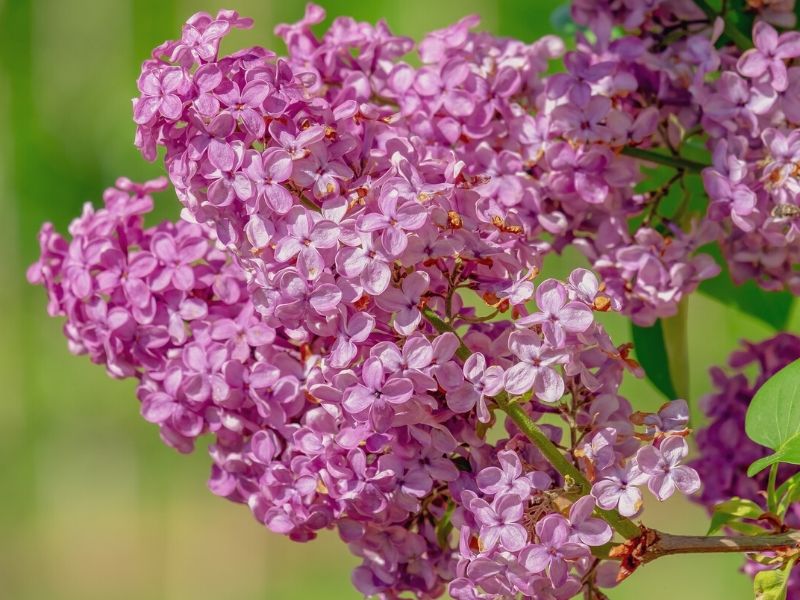
After being exposed to a long winter chill, lilacs produce wands of beautiful florets that give the spring season defined fragrance and color.
In the garden, they are used as screens because of the tall growth of the shrub and as a hedge since it provides colors that lead the eyes. The clusters of tubular flowers range from light purple to magenta and they bloom best under a sunny condition.
To ensure a prolific bloom next spring, lilac heads are removed when they start to dry. The plant does well in fertile soil and is commonly grown with other colorful plants like Siberian iris and bleeding heart (25).
Jacob’s Ladder
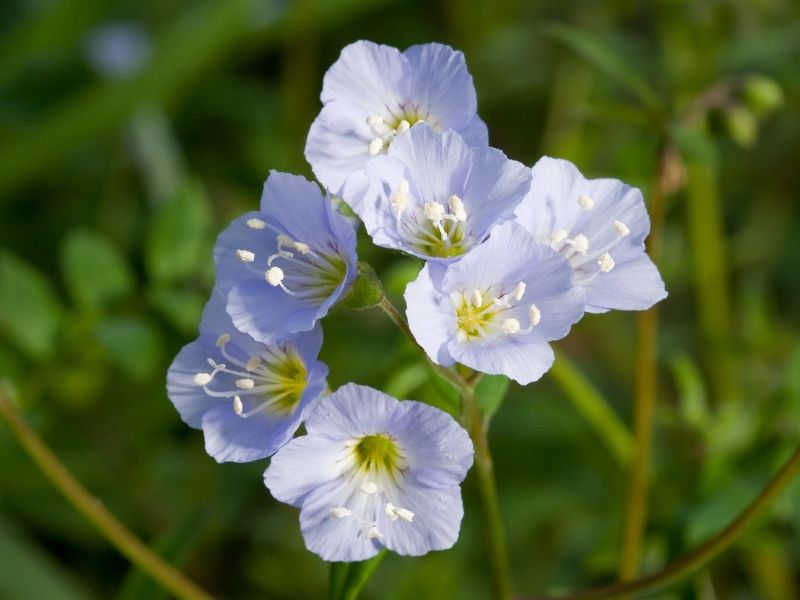
Jacob’s ladder got its name from the ladder-looking formation of the plant’s leaves but what makes it stand out as spring plant is the majestic cluster of flowers it produces.
Bright blue is the common color of the flowers that bloom at the end of each stem but other varieties also come in white, pink, and yellow (27).
This plant like it partially shaded so they thrive well under tree canopies, they just need to be watered occasionally, keeping the soil moist. Repeat blooming can be initiated by cutting the flower stalks to the plant’s base when the first flowers have wilted.
Geranium
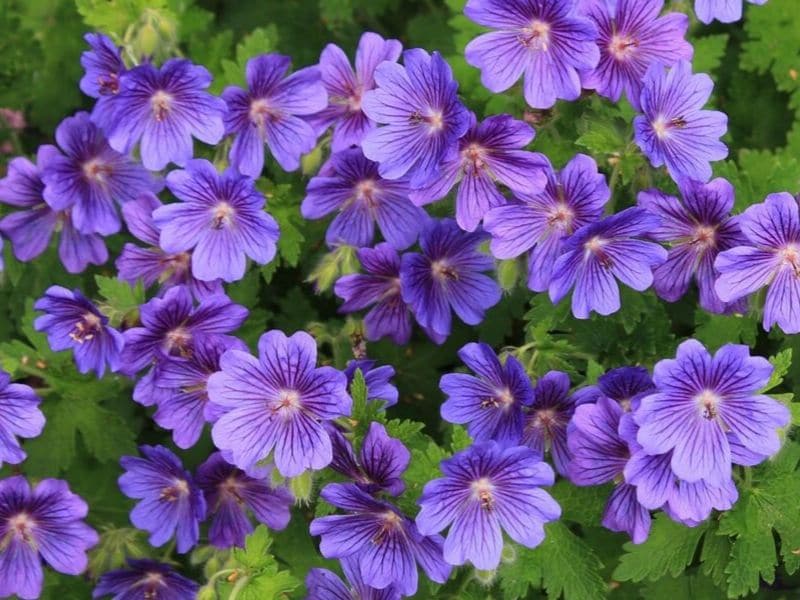
True hardy geraniums are small shrubs that form mounds and are perfect as a mass planting in a landscape. They are also used as companion plants under roses since the bright green leaves provide a contrast with the darker foliage.
The delightful flowers usually have 5 overlapping petals and protruding anthers. Colors can be white, magenta, pink, and blue and in fact, geraniums are some of the few flowers that have a true blue color (13).
Geraniums flower late in spring but some varieties bloom non-stop, even making it throughout summer like ‘Rozanne’. ‘Ann Folkard’ is another cultivar that is a repeat bloomer and a bouncy trailing growth habit.
Malus coronaria
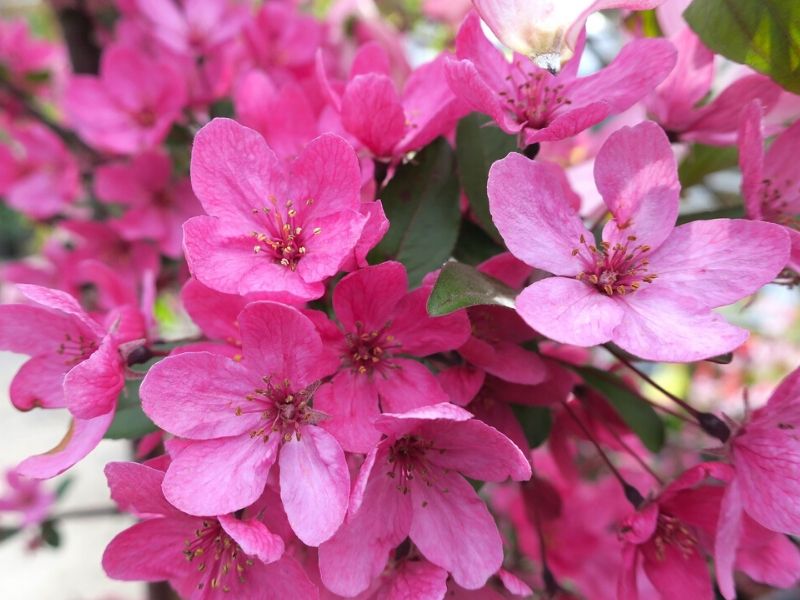
Malus, also called crab apple, is a member of the rose family that also displays attractive fragrant flowers. These blossoms are usually five-petaled forming clusters all over the spring-bare branches of the plant (27). Like humans, butterflies and birds are attracted to this showy display of spring blooms.
Crab apples have medicinal properties as well. The bark is used in treating gallstones and bruises and the roots are boiled to relieve cramps. The fruits are nutritious and the leaves and flowers are edible too. The plant is traditionally grown in both English and American gardens
Magnolia grandiflora
Magnolias signal the beginning of spring but many species only start blooming in the latter days of the season. These are mostly the evergreen magnolias including M. grandiflora. This species is considered the grandest of the magnolias with its straight trunk, glossy evergreen leaves and fragrant beautiful creamy white flowers (16).
Other deciduous magnolias that provide more bright colors to the spring season are pink lilac ‘Saucer Magnolia’, multi-petaled ‘Star Magnolia’ and the reddish-purple ‘Jane’ variety.
Myrtle
The small genus of myrtle is enough to produce an abundance of blossoms in spring. They are native to the Mediterranean and Western Asia and are popularly cultivated as ornamental and aromatic plants. The beautiful white flowers are small and glossy leaves have a unique calming scent (25).
The flowers are symbolic of innocence, purity, and good fortune and this makes them popularly grown in residential gardens. Aside from this, myrtles have medicinal properties used in treating respiratory illnesses and their leaves and fruits make good culinary ingredient too, adding unique flavors and aroma to dishes.
Chestnut oak
Also commonly called quercus montana, this is a deciduous tree that loses its glossy green foliage for the cold winter but comes mid to late spring, long textured stalks of yellow and red flowers called catkins appear on the bare branches swaying to the cool spring breeze.
Chestnut oaks are resistant to the majority of pests and diseases but they can still be attacked by borers, weevils, and leaf miners but nothing that can be controlled by beneficial insects (27).
When the tree is fully clothed with broad leaves, it provides shade in the garden and home to birds and squirrels. The flowers that turn into acorns are also fed on by livestock. The tree also provides good sturdy wood used as flooring and posts.
Peonies
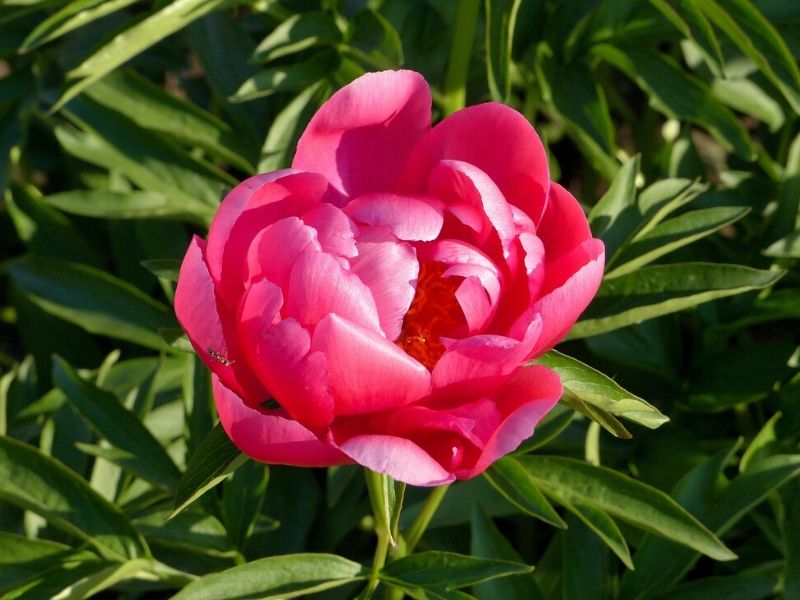
The fluffy, showy peony blossoms are considered by some as the ‘Queen of Spring Flowers’. They are large and ruffled that come in pink, red, yellow, and white and with the sweet fragrance, who wouldn’t want them not just for spring but the rest of the year? They are fairly easy to grow since the plant can thrive in any climate and it provides abundant spring blooms for many years.
Some peonies are perfect to be planted as garden accent and edging and some species with longer floral stalks and bigger flower heads are selected as cut flowers used in bouquets and flower arrangement (27).
Primrose
Primroses have lovely yellow flowers with a darker yellow center and glossy dark green leaves with a prominent midrib. These are usually found covering the grounds of woodlands and in gardens, they are grown as hedgerows. The flowers are fragrant and are popular among pollinators.
Primroses love partial shade and will need frequent watering when grown in full sun areas. They only grow up to a foot high and the spring blooms only last for 6 weeks (Edsall). Nevertheless, they will definitely brighten and dark garden spaces, especially when grown together with hostas and ferns.
Prunus glandulosa
Also called dwarf flowering almond or Chinese bush cherry, this plant is a small shrub with multiple stems that get filled with outstanding soft pink flowers in the latter days of spring (27).
It is a native of China and Japan and was introduced to Europe and America where it is dubbed as ‘the gem of our grandfather’s garden’. The plant is popular as a front-yard focal point but it can be effective when planted in mass with large shrub beds.
Some priced varieties are the ‘Roseas Plena’ bearing carnation-like pink double flowers and ‘Alba Plena’, a rare cultivar with snowy white flowers.
Pulsatilla vulgaris
Pulsatilla vulgaris or pasque flower is a perennial herbaceous plant native to Europe. This small plant has long silvery leaves forming a rosette and in spring, enchanting purple bell-shaped flowers bloom in the middle of these leaves (27).
Pasque flowers grow in meadows and sloping areas and they even appear on old barrows.
A European legend tells about how pasque flowers bloom where the blood of Roman soldiers killed in battle splashed. These spring flowers, despite growing in the wild, were collected in bunches and were given during Mother’s Day in Finland.
Siberian bugloss

Siberian bugloss got its name from the Greek term for ox tongue in reference to the rough texture and shape of the plant’s silvery leaves. But what makes it a remarkable spring plant is the floral spray it produces.
The small bright blue flowers are so charming, they can compete with other colored-flowers in the garden. They last for weeks, even making it through the early days of summer (27).
As much as possible, Siberian bugloss should not be kept dry. It prefers moist soil so they can be observed growing towards some water sources. They tend to grow vigorously so pruning should be regularly performed.
Spring Snowflake
The scientific name of this plant is Leucojum vernum, a member of the bulbous family of Amaryllis. It is often confused with snowdrop, a relative of amaryllis but this plant is taller and wider strap-like leaves. The fragrant bell-shaped flowers are white with yellow or green dots on the underside of the outer petals (4).
Spring snowflakes provide a beautiful background to the other low-growing and colorful spring flowers. But this time of the year also entails infestation of snails and slugs which love to feast on the soft stem and leaves of snowflakes so an effective solution is the application of crushed egg shells on the surface of the planting area which will irritate the soft bodies of these molluscs.
Tulips
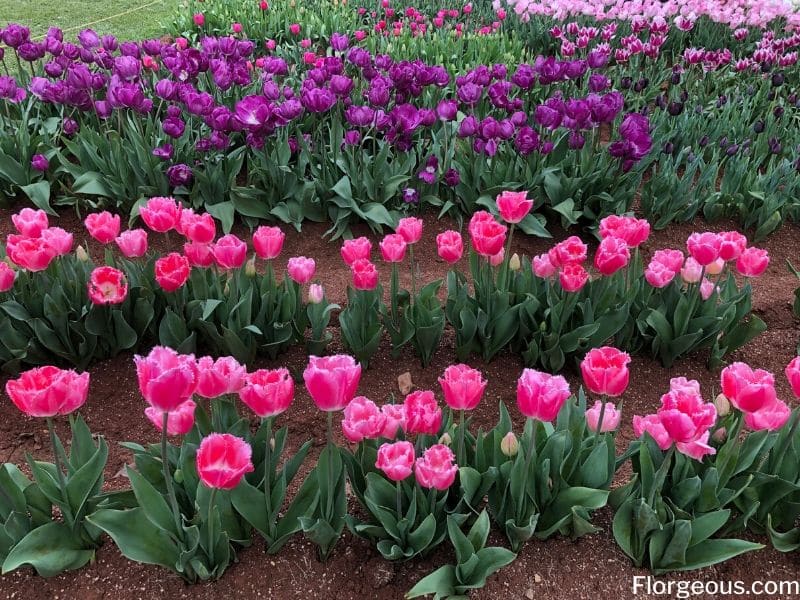
One of the favorite flowers of spring, if not the most popular, is the tulip flower. This herbaceous plant screams the colors associated with the spring season and one can never go wrong planting them in the garden. The name tulip is said to be derived from the word “turban”, a Persian headdress which the flower resembles.
Tulip has a unique appearance and has been cultivated for many years because of this. This is also considered the reason why many tulip varieties today have a hard time blooming for more than once a year. Tulips are considered annuals and are replanted every year to prepare for the spring bloom (4).
Yellow trillium
Yellow trillium is a unique plant that grows from underground structures called rhizomes. The above-ground stem is just an extension of the rhizome that produces scale-like leaves called cataphylls. These stalkless green leaves have gray splashes and on top of the leaves sits the twisted lemon-scented yellow flower that blooms in spring (27).
Yellow trilliums are attractive plants that grow only half a meter high making them perfect as edging or border plants. Growing them in gardens requires experience because of the unusual growth habit but the spring blooms they produce make it totally worth it.
References
Reference List:
(1) Croaker, Andrew et al. “Sanguinaria canadensis: Traditional Medicine, Phytochemical Composition, Biological Activities and Current Uses.” International journal of molecular sciences vol. 17,9 1414. 27 Aug. 2016, doi:10.3390/ijms17091414. – link
(2) Hanson, B. “Spring blooming bulbs: an a to z guide to classic and unusual bulbs for your spring garden.” Brooklyn Botanic Garden, vol. 173. 2002. Pp. 111.
(3) Le Strange, Michelle. “How to Grow Carefree Camellias.” Master Gardener Newspaper (University of California). 2009. P. A11.
(4) Hole, J. and Hole, L. “Bulbs: Practical advice and the science behind it.” Hole’s. 2005. P. 144.
(5) Peters, G. “Coltsfoot.” The American Agriculturist, vol. 42. 1883. P. 375.
(6) Hanks, G. “Narcissus and Daffodil: The genus narcissus.” CRC Press. 2002. P. 452.
(7) Nicholls, S. “Flowers of the field: meadow, moor and woodland.” Head of Zeus Ltd. 2019. Pp. 448.
(8) Coronado, S. “Illinois getting started garden guide.” Cool Springs Press. 2014. Pp 240.
(9) Smith, G. and Van Wyk, BE. “The garden succulents primer.” TimberPress. 2008. P. 320.
(10) Cleveland Museum of Natural History. “The Explorer.” 1981.
(11) “Perennials, best of fine gardening”. Taunton Press. 1993. P. 95.
(12) Johns, CA. “Flowers of the Field.” Routledge Kegan Paul. 1949. P. 356.
(13) Edsall, M. “Roadside plants and flowers.” University of Wisconsin Press. 1985. P. 143.
(14) Sud, RK. And Kumar, S. “Flowers and Vegetables of India.” Scientific Publishers. 2017. P. 275.
(15) Vizgirdas, R. and Vizgirdas, E. “Wild Plants of the Sierra Nevada.” University of Nevada Press. 2009. P. 384.
(16) Swaminathan, MS. and Kochhar, SL. “Major flowering trees of tropical gardens.” Cambridge University Press. 2019. P. 416.
(17) Simeone, V. “New York and New Jersey getting started garden guide: grow the best flowers, shrubs, trees, vines and groundcovers.” Cool Springs Press. 2015. Pp. 208.
(18) Wichham, J. “Gardener’s World: 101 shade-loving plants, ideas to light up shadows.” Random House. 2016. Pp. 216.
(19) Schulze, E.D. et. al. “Plant Ecology”. Springer Science and Business Media. 2005. P. 702.
(20) Li, HL. “Chinese flower arrangement.” Courier Corporation. 2012. P. 144.
(21) Roecklein, J.C. and Leunf, P. S. “A profile of economic plants.” Transaction Publishers. 1987. P. 623.
(22) Cullina, W. “The New England wild flower society guide to growing and propagating wildflowers of the United States and Canada.” Houghton Mifflin Harcourt. 2000. Pp. 322.
(23) Clausen, R.R. and Christopher, T. “Essential perennials: the complete reference to 2700 perennials for the home garden.” Timber Press. 2015. Pp. 428.
(24) Randhawa, G.S. and Mukhopadhyay, A. “Floriculture of India.” Allied Publishers. 1986. Pp. 660.
(25) Miller, G. O. “Landscaping with native plants of the Southwest.” Voyageur Press. 1997. P. 58.
(26) Phillips, J. and Irish, M. “Arizona and New Mexico getting started garden guide.” Cool Springs Press. 2014. Pp. 240.
(27) Tenenbaum, F. “Taylor’s Encyclopedia of Garden Plants.” Houghton Mifflin Harcourt. 2003. P. 447.
(28) Ornduff, R. et. al. “Introduction to California plant life.” University of California Press. 2003. P. 341.
Close

